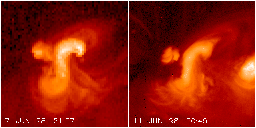 We have many
observations of the eruption stage in a sigmoid's life, such as this
classic (click on thumbnail to see a larger version), but our Whole Sun Month 3
observations allowed us to see how the region behaved over a much longer time.
We have many
observations of the eruption stage in a sigmoid's life, such as this
classic (click on thumbnail to see a larger version), but our Whole Sun Month 3
observations allowed us to see how the region behaved over a much longer time.
 We have many
observations of the eruption stage in a sigmoid's life, such as this
classic (click on thumbnail to see a larger version), but our Whole Sun Month 3
observations allowed us to see how the region behaved over a much longer time.
We have many
observations of the eruption stage in a sigmoid's life, such as this
classic (click on thumbnail to see a larger version), but our Whole Sun Month 3
observations allowed us to see how the region behaved over a much longer time.
There was a huge quantity of data to assimilate, but we will concentrate on two types; the SXT observations, and H alpha observations. H alpha observations show up a filament - a long narrow mass of cool, dense material suspended in the solar atmosphere and approximately aligned with the SXT sigmoid. This shows up as a dark straggly line on H alpha images.
Click here for an SXT whole sun movie for that week, and here for an H alpha movie showing the northern hemisphere. Watch for the region which rotates across the northern hemisphere, crossing the central meridian about August 19th. You will see that the SXT region is active in the beginning, with flares and cusps, while the H alpha filament develops then disappears, then reappears again.
Below is a series of thumbnails, roughly one per day of the active region seen by SXT and the filament seen in H alpha by the Big Bear Solar Observatory. Each thumbnail links through to a page describing briefly the evolution of the sigmoid and its associated filament.
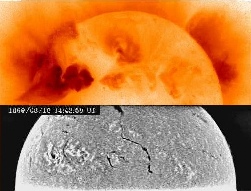
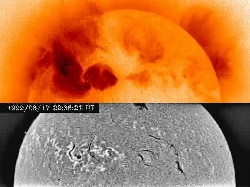
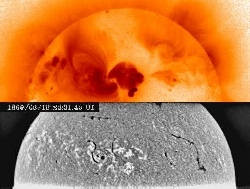
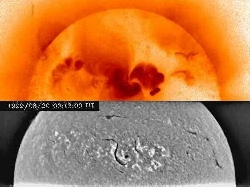
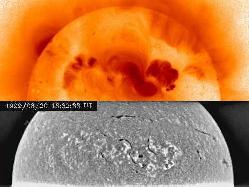
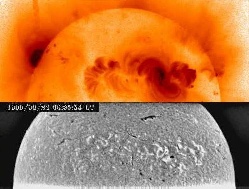
So what we see is that the `S'-shaped filament and the SXT sigmoid form at different times. When it first appears, the SXT active region is very bright and active, while the filament is forming. When the filament is at its best, the active region has not yet settled back down into a symmetric `S'. And by the time the SXT sigmoid is at its best, the filament has upped and gone.
To try and understand the evolution of the region, we have to consider what it is that allows us to see the SXT loops and the H alpha filament, and why they are S-shaped. First of all, we think that the S-shapes show up because the magnetic field in a sigmoidal active region has an inherent twist. Twist means stored energy (which can in principle be measured). But we do not see all of the S's - all of the field - all of the time.
We think that we see the sigmoid in SXT when some subset of this twisted field, or the interface between it and the rest of the corona, is being heated and excited. The filament, on the other hand, needs stability. Stable magnetic support is necessary for the dense filament to stay up in the corona - without it the material would drain back down into the photosphere.
We also know that the H alpha filament is formed low down in the atmosphere whereas the SXT loops are much larger and higher, as this series of images of another filament shows. In effect, the SXT loops surround the filament.
 H alpha
H alpha
 EIT 304
EIT 304
 EIT 195
EIT 195
 SXT
SXT
So we propose that during the first couple of days, the active region, loaded with energy, is `settling into' the corona. As it does so, loops high up in the active region (which butt up against the rest of the coronal field) flare and make cusps, and are therefore bright in SXT. But as it flares the region also is getting rid of some of its pent-up energy and quieting down. Note, it can't get rid of all of its extra energy as global helicity must be conserved (i.e. the sum of the twist of the active region and the twist of the surroundings); therefore the active region maintains its S shape. The field becomes more stable, and the filament can form. The filament becomes fat and healthy as the magnetic field enters a period of a couple of days of calm - but the quiet is deceptive. The magnetic field is continually changing in the active region, driven by changes lower down, and around the 21st it is disrupted enough that the filament starts to move and disintegrate. As a result the overlying magnetic field has to find a new equilibrium in its coronal home, and starts to interact and rearrange itself, resulting in the brightening up of the SXT sigmoid.
This is of course only one of many possible interpretations, but it seems to fit the picture, and also explains lots of other data which we don't present here. Fingers crossed our referee will like it!